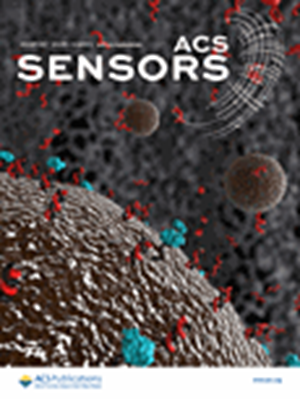等离子体石墨烯-金纳米星形异质结用于c反应蛋白的红光电化学免疫传感
IF 9.1
1区 化学
Q1 CHEMISTRY, ANALYTICAL
引用次数: 0
摘要
红光光电化学(PEC)纳米免疫传感器的发展为检测具有高灵敏度和特异性的临床相关生物标志物提供了新的途径。本文提出了第一个基于等离子体石墨烯和金纳米星(AuNS)异质结的PEC纳米免疫传感器,该传感器基于765 nm红光激发,用于无标记检测c反应蛋白(CRP),这是炎症的关键生物标志物。该平台利用AuNSs独特的局部表面等离子体共振效应与原位生成的石墨烯相结合,提高了765 nm单色光下的光电转换效率。这种波长最大限度地减少了生物样品的光损伤和干扰。通过优化纳米结构和利用双功能光活性转导平台,实现了25-800 pg/mL的线性检测范围,检测限低至13.3 pg/mL。低能红光激活、有效的电子-空穴对分离和信号放大使CRP能够在来自低度慢性炎症患者的真实临床样本中快速、选择性和敏感地检测。纳米免疫传感器在多个样品中表现出一致的分析性能,显示出在炎症疾病中准确监测生物标志物的潜力。这项工作突出了等离子体纳米材料,以开发强大的PEC免疫传感器,提供可扩展、无创、自动化、低背景噪声,作为临床诊断的高灵敏度替代方案。本文章由计算机程序翻译,如有差异,请以英文原文为准。

Plasmonic Graphene–Gold Nanostar Heterojunction for Red-Light Photoelectrochemical Immunosensing of C-Reactive Protein
The development of red-light photoelectrochemical (PEC) nanoimmunosensors offers new avenues for detecting clinically relevant biomarkers with high sensitivity and specificity. Herein, the first PEC nanoimmunosensor based on a plasmonic graphene and gold nanostar (AuNS) heterojunction excited with 765 nm red light is presented for label-free detection of C-reactive protein (CRP), a key biomarker of inflammation. This platform leverages the unique localized surface plasmon resonance effect of AuNSs in combination with in situ generated graphene to enhance photoelectrical conversion efficiency under 765 nm monochromatic light. This wavelength minimizes photodamage and interference from biological samples. By optimizing the nanoarchitecture and utilizing a bifunctional photoactive transduction platform, a linear detection range of 25–800 pg/mL is achieved, with a limit of detection as low as 13.3 pg/mL. The low-energy red-light activation, effective electron–hole pair separation, and signal amplification allow CRP’s rapid, selective, and sensitive detection in real clinical samples from patients with low-grade chronic inflammation. The nanoimmunosensor demonstrated consistent analytical performance across multiple samples, showing potential for accurate biomarker monitoring in inflammatory disorders. This work highlights plasmonic nanomaterials to develop robust PEC immunosensors that provide scalable, noninvasive, automated, low-background noise as a highly sensitive alternative for clinical diagnostics.
求助全文
通过发布文献求助,成功后即可免费获取论文全文。
去求助
来源期刊

ACS Sensors
Chemical Engineering-Bioengineering
CiteScore
14.50
自引率
3.40%
发文量
372
期刊介绍:
ACS Sensors is a peer-reviewed research journal that focuses on the dissemination of new and original knowledge in the field of sensor science, particularly those that selectively sense chemical or biological species or processes. The journal covers a broad range of topics, including but not limited to biosensors, chemical sensors, gas sensors, intracellular sensors, single molecule sensors, cell chips, and microfluidic devices. It aims to publish articles that address conceptual advances in sensing technology applicable to various types of analytes or application papers that report on the use of existing sensing concepts in new ways or for new analytes.
 求助内容:
求助内容: 应助结果提醒方式:
应助结果提醒方式:


